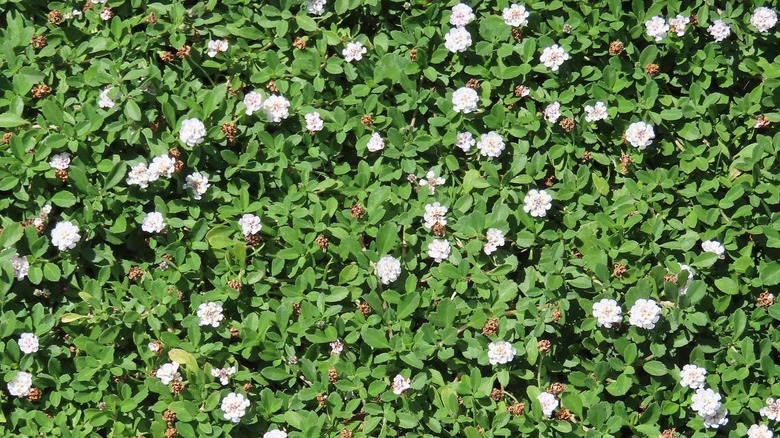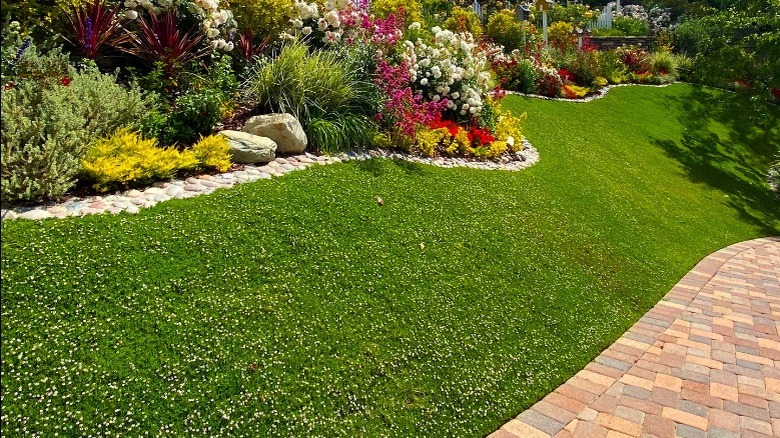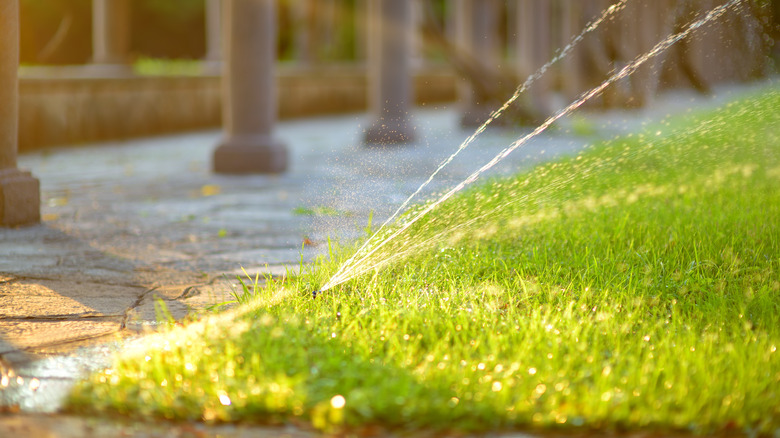The Benefits Of Growing Heat-Tolerant Kurapia As A Ground Cover
If you've been striving for a great lawn for months (or years) to no avail, you're ready to jump at the first thing that promises a lush, green turf. Fortunately, there is a novel ground cover plant — Kurapia — that promises all of the characteristics you've been seeking, and it's designed to especially thrive in environments that are hot and have limited rainfall.
First developed in Japan, there is much to love about Kurapia. This dense groundcover plant quickly establishes deep roots. Benefits include its speed of establishment from plugs, which can take a mere two to three months. It also naturally keeps its height limited, meaning that you might not have to mow often, if at all. While many types of traditional grasses struggle with lawn burn in the summer, Kurapia is ideal for warmer climates, preferring zones of 7b and higher (which is anywhere with lows of 45 degrees Fahrenheit or hotter). It will begin to go dormant after the temperatures drop lower than 38 degrees Fahrenheit, so it is not recommended for cooler zones. While it can be very expensive when compared to other grass options, the benefits of a low-maintenance, green lawn may be well worth it if you live in a dry, hot climate.
Why you should consider a Kurapia lawn
Many of the perks that are inherent to Kurapia stem from the fact that it is not a typical grass, but rather a ground-covering plant. Kurapia quickly spreads out to cover the soil it is planted in, so long as the dirt is not overly compacted (bear in mind that it favors sandy-to-sandy loam soils). Since Kurapia keeps itself quite short, you can choose how often you should mow — if at all— depending on your preferences. While some people cut Kurapia down to 2 to 3 inches high in order to prevent the plant from flowering (its flowers are delicate and white), others may not mow it at all and find that it reaches only a three-inch maximum height.
Kurapia also naturally works to prevent erosion on sloping pieces of land, thanks to its running root systems that can quickly cover hills and uneven ground. The overall density, of Kurapia can help to hold weed growth at bay, although it can also choke out other grasses if it takes off, so it's best to not try to mix conventional grasses with Kurapia. For individuals who are worried about watering needs, Kurapia's got you covered, as it requires only light watering. Once weekly should do it after the ground cover is established, as the deep roots can provide the grass moisture and nutrients for long periods of time.
How to successfully plant Kurapia
While Kurapia is easy to maintain once established, preparing for a successful installation will increase the chances of a thriving ground cover. For starters, so long as you're in the right zones for it, Kurapia can be planted any month of the year, but you'll get the best results if you plant it between March and September when temperatures are warm.
If your soil is clay or otherwise difficult to dig in, you should aerate the soil. Aerating at least the top four inches of compacted dirt will give the Kurapia a chance to take root and spread. And while Kurapia is likely to kill off weeds once it is established, you'll want to give your new lawn a fighting chance by pulling weeds prior to installing the plugs. When planting the plugs themselves, ensure that they are planted in large enough holes (at least twice the size and depth of the plug). Once the plug is in the ground, lightly pack the soil around the plug's soil, planting each plug about 15 inches from the next. Frequently water the plugs from above, so the water wets the plugs themselves, rather than the soil. As the weeks progress, you'll want to keep the soil moist, while being careful to not harm the ground cover by using high pressure. With any luck, you'll be enjoying a lush Kurapia lawn in a few months.


